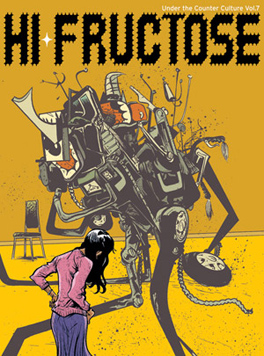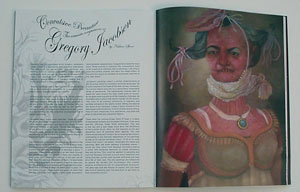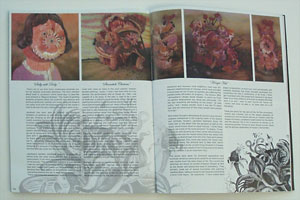
GREGORY
JACOBSEN - Convulsive Beauties
Hi Fructose Magazine
Volume 7, 2008
By Nathan Spoor
Entering into Chicago-based artist Gregory Jacobsen’s visual forum
is a fascinating and beguiling experience. The effects of his self-ascribed “pile
paintings” are nothing short of viewing a perilously crafted ballet
of grotesques – each one set on view for an unsuspecting voyeur and
would-be lover. These obsessive creations portray a sensual dynamic of grotesque
making love to truth, resulting in a rare and passionate vulnerability.
Gregory Jacobsen, now 31, has the affect of one accepting life as each moment
is presented. He is pragmatic, with heavy doses of existentialism and nihilism.
Although very sexual in nature, his works are not so easily classified as
the dime store mainstreams of psychology one might assume. While the artist
claims to subscribe to no one school of thought, his views of Freudian theories
on repression and sexuality, as well as the mystical nature of Jung’s
archetype (an integration of spirituality and appreciation for the collective
unconscious) are of equal importance.
Jacobsen rarely works from sketches. These paintings are more immediate,
though he’s reluctant to write them off as merely “automatic” and
reject any simple-minded “symbol” reading of his work. Therein
lies the enigma of the artist’s struggle. That amazing creative impetus
being eternally locked in the struggle of the ritualistic deflowering of
the surface in a grand performance of vulnerability and dignified ambivalence.
The limitations of Jacobsen’s work are not evident in the final products
of his efforts, but they’re there. In his eyes, the laborious process
of drafting, sketching, planning a piece is a confining yet integral process. “I
don’t plan these paintings so much as feel them through the growth
process,” he begins. “There are months of work under each surface.
The failures of the past are all built up in this glorious movement of flesh.
I’m fascinated with making flesh look more realistic. I tend to sand
over months of work, several versions of a single painting even, to achieve
a glimpse of what I’m attempting to paint. It’s the layers, though,
those layers and layers of work that give the paintings their depth. I need
more movement, more dynamic compositions. Compositions need the most work.
While working in sketches the compositions have to be erased and reworked.
But in paintings I can simply sand the surface smooth and have the added
effect of the previous layers of mistakes to eventually lead me to the right
place.”
Jacobsen’s paintings reflect a certain understanding of life structure
within a constantly evolving landscape. As a youth playing in the fields
of the New Jersey riverbanks, his curious nature took him on a particularly
remarkable series of adventures. The haphazardly covered piles of waste dirt
piled around the town made quite an impact. As he grew more inquisitive of
the changing cityscape, he stumbled upon a place that would change his life
forever – the ruins of an outlying community of vagrants and societal
outcasts in the nearby woods. Being just beyond the fence of his back yard,
Gregory found himself in his new playground constantly. This forest had piles
of everything. Piles of trash, magazines, toys, appliances. Just piles and
piles of discarded and unwanted objects.
These were the coming-of-age times of hope in a place of abandoned dreams
and discarded fortunes. Fires were erected, offerings made, fluids exchanged.
This was a new day and a new stage. Gone were the inhibitions of the outside
forum. Here, no one imposed on him any opposition borne of someone else’s
agenda. This new drama would stay with the Gregory as an ongoing fascination,
culminating in the frenzied realizations of his paintings as well as its
natural courtesan – music. "A lot of my work comes from music,” he
states, “especially the newer pile paintings. With the more tableaux
orientated pieces- I would say they come from Musique Concrete - creating
a scene with disparate elements to create something new and jarring. This
could be applied to sampling and such but Musique Concrete is much more theatrical
with using everyday sounds that become animated and take on a life of their
own. With the pile paintings, they are influenced by people like Xenakis
and Stockhausen who created massive architectures out of compositional structures.
The piles may look like masses of chaotic shit, but there was a lot of planning
and trial and error to get them to their monolithic forms.”
That’s not to say that these challenging pictorials are too far beyond
reasonable definition. The term bandied about most in Jacobsen’s world
these days to describe such artwork is “Magical Realism”. This
realm of painting presents artworks where the scientific and physical realities
and spiritual human realities are fused. Here, the illogical can safely exist
with the knowing that it is the viewer’s task to decode the texts hidden
within each piece of art. And in this, Gregory cites French writer and doctor
Louis-Ferdinand Céline as an inspiration for his optical forays. Céline
(1894 – 1961) one of the most influential writers of the twentieth
century, developed a new style of writing. This style, which Jacobson hails
so highly, was presented riddled with such dark humor, anxiety and pessimism.
But it was done in a rhythmic manner that broke barriers in the field, managing
to embody human emotion as literature. This rhythm that Céline blessed
Gregory with has been a mainstay influence in his workings with his musical
troupe and band, Lovely Little Girls. He’s been able to unleash his
childhood torments growing up with fetishes attached to food and sex. Growing
up with an unsatisfied desire for the readily available hamburger-helper-style
fare with sides of potato chips and ding-dongs made for one gregariously
rotund individual. “I was a fatty for a number of years,” he
confesses. “I eat pretty healthy these days and my diet doesn't deviate
much. I love trying new foods but rarely go out to restaurants because of
the social fanfare that goes with it. My loss though. I have been a vegetarian
for many years and obsess over meat, daring myself to eat it... something
disgusting like McDonalds... but can never bring myself to do it. There's
a little bit of sexual titillation in it because it is so taboo for me. This
is where the food and sex come into the paintings.”
Jacobsen’s earliest childhood memory is attached to falling down the
cellar stairs, but the next is possibly the more potent, if not more fascinating
view into the course of his journey. “The ‘art and sex’ memory
is from the day I was out painting the driveway gravel with the girls next
door who I always had crushes on. I always envied the girls because they
were always so much better looking, more interesting looking and got to wear
better clothes. Another memory is sticking my sweaty socks in my mouth, being
immediately disgusted and not being able to get the greasy taste out of my
mouth for days.”
These memories are sandwiched together in a mind that could only chew on
them in the most polemic manner besides painting – music. “I
wish I had more time to truly develop the performance end of things as I
feel I am capable of a lot more. In the past it used to be a sort of freak-out,
a cathartic experience on stage...but as my painting has gotten more disciplined
and thought out, the music/performance followed suit. Right now we as a band,
Lovely Little Girls, are working hard at creating something new that is very
theatrical and somewhat ritualistic (in a disciplined manner rather than
hippy-dippy soupy drones and chants) while also retaining a dark humor...which
is how I would describe my paintings at times. One of our big influences
is Magma, a French Zuehl group who created their own language and mythology
and who (at least in their early work) had a malevolent sound and stage presence
that resembled a Catholic Church ceremony.”
Gregory eloquently speaks at length about his dual-natured persona and its
effects on his nature, laughingly enough. ”This of course is filtered
through my innate goofiness. No matter how hard I try to fight it...I have
always been pretty fucking goofy. But I have always approached everything
(painting, performance) with utter seriousness...like Buster Keaton or Peter
Sellers. I often find myself getting too damn serious about things and I
have to whip out a bunch of drawings with spurting cocks and laughing animals
(like right now).”
Besides pursuing his performances with his band, his fascination with the
Internet and collecting avant-garde and outsider music, Jacobsen is most
influenced by his surroundings in his Chicago habisphere. More specifically,
the downfall of the old beautifully built but decaying buildings for the
new gentry of yuppified living situations and nouveau riche neighbors. Even
now, his beloved neighborhoods of Chicago, which have provided the home base
for his 13 year occupation, are suffering the prefabricated affrontery of
progress. The historic 1929 “atmospheric”- styled movie theatre
in which he finds his gainful employment lies tense but untouched. “It’s
the last remaining old building on the street,” he coos softly, “and
I always wonder what it was like 70 years ago, and am conscious of how many
people have passed through.”With these thoughts demanding all precious
and relevant soapbox momentum in his ongoing realm of the bizarre and intimate,
Gregory Jacobsen maintains focus. He holds fast to the belief that the personal
as well as the larger world issues deserve equal footing. “I think
these pieces are some of the most personal,” he begins. “It has
a lot to do with growing up in New Jersey and hanging out in the dumps and
the woods where there was always shit washing up downstream from the river,
there were always piles of garbage. Also, there was always the 'lesser than'
feeling of being 'the shithole next to New York' (which can be extended to
my current living situation in Chicago where Mayor Daley seems to be inviting
a terrorist attack just to validate Chicago as an important city). The piles
hint at a history and a little bit of a narrative. They were obviously constructed
by someone and were either built really half-assed or someone came in and
fucked them up.
The works have been his imminent aggravation and eventual salvation, echoing
his needs for an effective and safe respite from the daily chaos of life.
The current pile paintings are found to contain immense thought as well as
the tender and passionate hand of immediacy. “They actually came out
of severe frustration with painting, sanding down, taking a chisel to the
masonite and finding a form from there,” he comments. “I have
always been drawn to monolithic architecture, food photography and scientific
drawings and these mistakes developed into something that was a combination
of all three. I often get frustrated with the human form because it has been
taken in so many different directions by people who have done it so well.
I want to paint figures like Ingres, but I know I will never be able to.
So these piles are a bit liberating.”
These are works for the faint of life, for the uncommon, unseen and unheard.
Out of the basest elements of recollection and the severe natures of creation
come the images of Gregory Jacobsen’s sweet lament for the idiotic
and the obscure. His is not a question of choices, or of becoming another
version of some distant puzzle. These are the glorious obsessions of mystery
and wonder.


